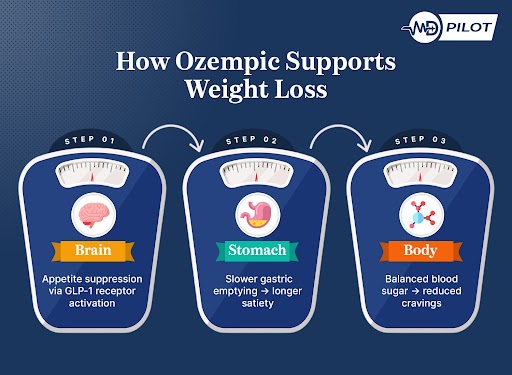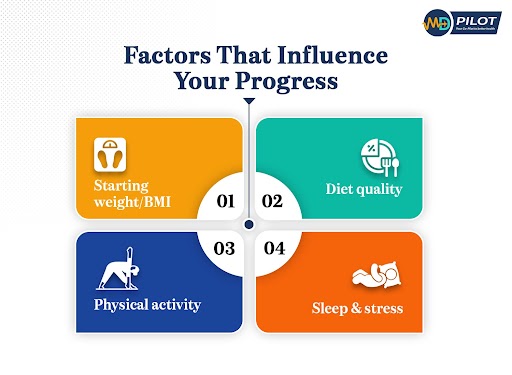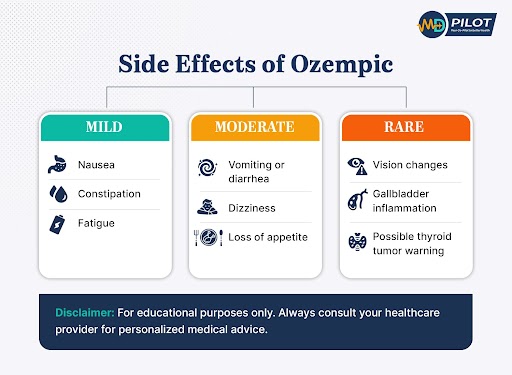Table Of Contents
-
Key Highlights
-
How Ozempic Actually Works to Help You Lose Weight
-
The Ozempic Weight Loss Timeline (Month-by-Month Overview)
-
What Affects How Quickly You Lose Weight
-
Managing Side Effects and Setting Expectations
-
Staying on Track for the Long Term
-
Frequently Asked Questions (FAQs)
-
Building Long-Term Success with Ozempic
-
References:
If you are considering Ozempic (semaglutide) for weight loss, one of your first questions is probably, “How soon will I see results?”. Understanding what a realistic Ozempic weight loss timeline looks like can help you set expectations and stay motivated throughout your journey.
Ozempic supports weight loss and blood sugar control by activating GLP-1 receptors, the same pathways your body uses to regulate appetite and manage glucose levels. It was originally created to help people with type 2 diabetes but has since become widely used for effective weight management.
Here, you’ll learn how the Ozempic weight loss timeline typically unfolds and what changes you can expect as your body adapts during the first year.
Key Highlights
- Most people lose 10 to 15 percent of their starting body weight within the first year of using Ozempic.
- Weight loss usually begins after the first four to eight weeks, once your body adjusts to the medication.
- The most significant results often appear between months three and six, followed by a slower but steady rate of weight loss.
- Combining Ozempic with healthy eating and regular exercise improves long-term results and overall well-being.
- Plateaus are normal and can be managed with small changes to diet, activity, or dosage under medical guidance.
- Stopping Ozempic may lead to some weight regain, but healthy lifestyle habits help maintain progress.
- Individual results vary, and working closely with a healthcare provider ensures safe, effective weight management.
How Ozempic Actually Works to Help You Lose Weight
Ozempic is part of a medication group known as GLP-1 receptor agonists. These drugs act like a natural hormone that helps manage hunger and blood sugar. Originally developed to treat type 2 diabetes, Ozempic is now also prescribed for weight management because of its unique ability to reduce hunger and control eating habits.
The medication works in three key ways. It slows digestion to promote appetite suppression, increases feelings of fullness after meals, and stabilizes blood sugar to minimize energy crashes that often trigger cravings. Together, these effects make it easier to lose weight without feeling constantly deprived.

Most people begin Ozempic at a 0.25 mg starting dose to allow their bodies to adjust gradually. After several weeks, doctors typically increase the dosage to 0.5 mg or higher for optimal results. This steady escalation supports ongoing fat loss while minimizing discomfort from any early side effects such as mild nausea or fatigue.
It’s essential to remember that Ozempic is not a quick fix, but rather a tool that works best when used in conjunction with a balanced diet and regular exercise. Real progress depends on consistency, a healthy lifestyle, and close collaboration with your healthcare provider to personalize your plan.
The Ozempic Weight Loss Timeline (Month-by-Month Overview)
Understanding how weight changes over time with Ozempic can help you stay motivated and realistic. While results vary from person to person, most people follow a similar pattern observed in both clinical trials and real-world settings.
Weeks 1–4: The Adjustment Period
During the first few weeks, your body adapts to the 0.25 mg starting dose. Appetite changes begin, but the scale may not shift dramatically yet. Many people notice reduced cravings and fullness — an early sign that appetite suppression is taking effect.
Mild side effects such as nausea, bloating, or fatigue are common but tend to fade with time. Most patients lose around 2–4 pounds in this stage as their bodies adjust.
Months 2–3: Steady Progress and Appetite Control
By the second month, the dose typically increases to 0.5 mg, and Ozempic’s appetite-regulating effects become stronger. Around this stage, most people begin to lose weight more consistently, averaging 1–2 pounds per week as their body adjusts. This aligns with findings from semaglutide clinical trials, which show an average reduction of 5–7% in body weight by the three-month mark.
Months 4–6: Peak Weight Loss Phase
This is when most users experience significant weight loss. Appetite is well-controlled, cravings are reduced, and energy improves. Patients often report steady progress and stronger motivation as physical changes become visible.
In clinical trials, people lost an average of 10–15% of their body weight over this period when Ozempic was combined with diet and exercising. The average person may lose 12 to 24 pounds within six months of consistent treatment.
| Time Period | Average Weight Loss | Key Milestones |
|---|---|---|
| Weeks 1–4 | 2–4 lbs | Appetite control begins |
| Months 2–3 | 8–12 lbs | Visible weight changes |
| Months 4–6 | 12–24 lbs | Peak weight loss phase |
| Months 7–12 | Continued gradual loss | Plateau and long-term focus |
Months 7–12: Plateaus and Long-Term Adaptation
After the first six months, weight loss often slows as metabolism adapts to your new body composition. This gradual slowdown is a normal part of the process and is commonly known as a weight-loss plateau. Even though the scale may not change as quickly, health improvements such as better blood sugar levels, increased energy, and enhanced overall well-being typically continue.
This stage focuses on long-term weight management. Maintaining a healthy lifestyle—balanced nutrition, regular physical activity, and adequate rest—helps preserve progress. Discussing a personalized maintenance dose with your healthcare provider can also support steady results and minimize the risk of weight regain over time.
What Affects How Quickly You Lose Weight
While Ozempic provides consistent appetite suppression and helps most people achieve steady weight reduction, the pace of progress still varies from person to person. Several biological and lifestyle factors influence how quickly you’ll see changes on the scale and in your overall health.
1. Starting Weight and BMI
Your starting weight often determines the rate and magnitude of weight loss. Individuals with higher body mass indexes (BMIs) typically lose a greater percentage of body weight early on because their calorie requirements are higher, creating a larger deficit as appetite decreases. However, smaller, steady losses are just as meaningful for long-term success.
2. Diet Quality
Ozempic helps you eat less, but the quality of your food choices still plays a critical role. Diets rich in lean protein, vegetables, and high-fiber foods support weight management and preserve muscle mass, while processed foods and sugary snacks can slow progress. Following a balanced healthy lifestyle reinforces Ozempic’s effects.
3. Physical Activity
Regular diet and exercising routines amplify results by boosting metabolism and improving insulin sensitivity. Patients who stay physically active — even with light daily movement or strength training — generally report faster and more sustainable progress than those who remain sedentary. The American Diabetes Association recommends at least 150 minutes of moderate activity per week for optimal results.
4. Sleep, Stress, and Hormones
Adequate sleep and stress management are often overlooked but essential for effective weight control. Chronic stress and poor sleep elevate cortisol levels, which can counteract Ozempic’s benefits and slow fat loss. Prioritizing 7–9 hours of rest and mindfulness practices can help maintain hormonal balance.
5. Other Medications and Medical Conditions
Certain medications — including antidepressants, corticosteroids, and beta-blockers — can make it harder to lose weight or affect metabolic rate. Conditions like hypothyroidism or polycystic ovary syndrome (PCOS) can also influence outcomes. Always discuss these factors with your healthcare provider to tailor your plan safely.

Managing Side Effects and Setting Expectations
Like all medications, Ozempic can cause side effects, especially during the first few weeks of treatment as your body adjusts. Most are mild and temporary, but understanding what to expect helps you stay consistent and confident throughout your journey.
1. Common Side Effects and How to Manage Them
The most frequently reported side effects include nausea, bloating, constipation, and fatigue. These typically occur during the dose-escalation phase, particularly when transitioning from 0.25 mg to 0.5 mg of the medication weekly.
To minimize discomfort:
- Eat smaller, slower meals and avoid high-fat or spicy foods.
- Stay hydrated and add fiber gradually.
- Rest when fatigue occurs and resume light activity when you feel better.
According to the Mayo Clinic, most people find that these effects fade after a few weeks once their body gets used to the medicine.
2. Serious but Rare Effects
Though rare, some people may experience more serious reactions such as persistent vomiting, vision changes, or gallbladder inflammation. Ozempic also carries a warning regarding possible thyroid tumors, based on animal studies. Patients with a family history of medullary thyroid carcinoma should consult their doctor before starting treatment.

3. Setting Realistic Expectations
Ozempic is most effective when paired with balanced nutrition, regular physical activity, and healthy sleep habits. It’s not intended for rapid or extreme weight loss but for steady, sustainable progress. Most users reach their peak results between months three and six, followed by slower, steady progress afterward.
The goal isn’t just to lose weight, but to develop habits that promote long-term health and confidence. Regular follow-ups with your healthcare provider ensure the treatment remains safe, personalized, and effective.
Staying on Track for the Long Term
Once you start seeing progress, the next goal is learning how to maintain your results and prevent weight regain. Long-term success with Ozempic depends on consistency, lifestyle integration, and maintaining close communication with your healthcare team.
1. Transitioning to a Maintenance Dose
After several months of steady progress, many patients discuss a maintenance dose plan with their provider. This helps stabilize results while reducing potential side effects. Some individuals continue Ozempic long term at a lower weekly dose, while others gradually taper it under medical supervision. Decisions should always be personalized based on your progress, comfort, and overall health goals.
2. Building Sustainable Habits
Lasting success with Ozempic goes beyond the medication itself. A healthy lifestyle — including nutrient-rich meals, regular physical activity, and proper sleep — remains the foundation for weight management. Continue practicing portion awareness and mindful eating even after appetite cues begin to return.
Consistency matters most. Research shows that people who follow structured meal patterns, limit processed foods, and stay active are far more likely to maintain their weight loss results over time.
3. Regular Check-Ins and Support
Staying connected with your healthcare provider ensures ongoing safety and accountability. Routine check-ins allow for medication adjustments, lab monitoring, and lifestyle guidance. Many patients also benefit from counseling, nutrition coaching, or support groups to stay motivated throughout their weight loss journey.
Remember: maintaining progress isn’t about perfection — it’s about persistence. Small, consistent actions every day will help you preserve results and feel your best over time.
Frequently Asked Questions (FAQs)
If you’re considering Ozempic or have already started treatment, it’s normal to have questions about what comes next. Below are some commonly asked topics that can help you make informed decisions throughout your journey.
Ozempic is generally used alone, since combining it with other weight loss drugs can increase side effects or reduce its effectiveness. Studies show semaglutide may slow digestion, which can affect how other medications are absorbed. Always consult your healthcare provider before adding or changing any treatments.
Stopping Ozempic abruptly can cause your appetite and cravings to return quickly, potentially leading to gradual weight regain. If you plan to discontinue treatment, your doctor can help you taper the dose slowly and create a maintenance plan that includes healthy eating and regular physical activity to support your results.
Yes. Beyond weight loss, many patients experience better blood sugar stability (lower HbA1c) when using Ozempic/semaglutide in the setting of type 2 diabetes. Clinical trials of GLP-1 receptor agonists (including semaglutide) demonstrate reduced rates of major cardiovascular events (e.g. heart attack, stroke) — benefits that extend beyond just losing weight.
Building Long-Term Success with Ozempic
Understanding the Ozempic weight loss timeline means recognizing that real results take time. Progress is steady, lasting, and built on consistent healthy choices.
Most people begin noticing results within two to three months, followed by gradual improvements in appetite control, energy, and overall well-being. Real success comes from pairing Ozempic with a balanced diet, consistent exercise, and mindful lifestyle habits.
By viewing Ozempic as a supportive tool rather than a shortcut, you can build a foundation for sustainable transformation and improved long-term health.
For ongoing guidance and practical tips, explore our expert-backed resources, including Low-Carb Foods & Alternatives. You can also check out our Restaurant Meal Planner, Optimal Meal Timing Calculator, and Personal Meal Planning Calculator to make smarter choices throughout your weight loss journey. All of these resources are designed to help you stay consistent, confident, and in control of your wellness goals.
References:
- Mayo Clinic. (2025). Semaglutide (Subcutaneous Route).
https://www.mayoclinic.org/drugs-supplements/semaglutide-subcutaneous-route/description/drg-20406730 - Mayo Clinic. (2025). Getting Past A Weight-loss Plateau.
https://www.mayoclinic.org/healthy-lifestyle/weight-loss/in-depth/weight-loss-plateau/art-20044615 - U.S. Food and Drug Administration (FDA). (2025). Drug Label Information. DailyMed.
https://dailymed.nlm.nih.gov/dailymed/drugInfo.cfm?setid=adec4fd2-6858-4c99-91d4-531f5f2a2d79 - Centers for Disease Control and Prevention (CDC). (2025). Tips for Keeping Weight Off.
https://www.cdc.gov/healthy-weight-growth/losing-weight/keeping-it-off.html - New England Journal of Medicine. (2024). Once-Weekly Semaglutide in Adults with Overweight or Obesity.
https://www.nejm.org/doi/full/10.1056/NEJMoa2032183 - Ghusn W, De la Rosa A, Sacoto D, Cifuentes L, Campos A, Feris F, Hurtado MD, Acosta A. (2022). Weight Loss Outcomes Associated with Semaglutide Treatment for Patients with Overweight or Obesity. JAMA Network Open, 5(9): e2231982. PMCID: PMC9486455.
https://pmc.ncbi.nlm.nih.gov/articles/PMC9486455/ - Shah, M., & Vella, A. (2014). Effects of GLP-1 on Appetite and Weight. Reviews in Endocrine and Metabolic Disorders, 15(3), 181–187.
https://pmc.ncbi.nlm.nih.gov/articles/PMC4119845/ - American Diabetes Association. (2024). Weekly Exercise Targets.
https://diabetes.org/health-wellness/fitness/weekly-exercise-targets - Min J., Jo S.J., Lee S., et al. (2025). A Comprehensive Review on the Pharmacokinetics and Drug–Drug Interactions of Approved GLP-1 Receptor Agonists. Drug Design, Development and Therapy.
https://www.dovepress.com/a-comprehensive-review-on-the-pharmacokinetics-and-drugdrug-interactio-peer-reviewed-fulltext-article-DDDT - Lingvay, I., Colhoun, H. M., et al. (2024). Semaglutide and Cardiovascular Outcomes by Baseline HbA₁c and Change in HbA₁c in People with Overweight or Obesity but without Diabetes in the SELECT trial. Diabetes Care, 47(8), 1360–1369.
https://diabetesjournals.org/care/article/47/8/1360/156810/Semaglutide-and-Cardiovascular-Outcomes-by
Disclaimer:
The information provided on MD-Pilot is for educational and informational purposes only. It is not intended as a substitute for professional medical advice, diagnosis, or treatment. Always seek the advice of your physician or other qualified healthcare provider with any questions you may have regarding a medical condition. Never disregard professional medical advice or delay in seeking it because of something you have read on this website.
Recomended Articles
View AllWeekly Health Intel
Get evidence-based health tips, latest research, and exclusive guides delivered weekly




